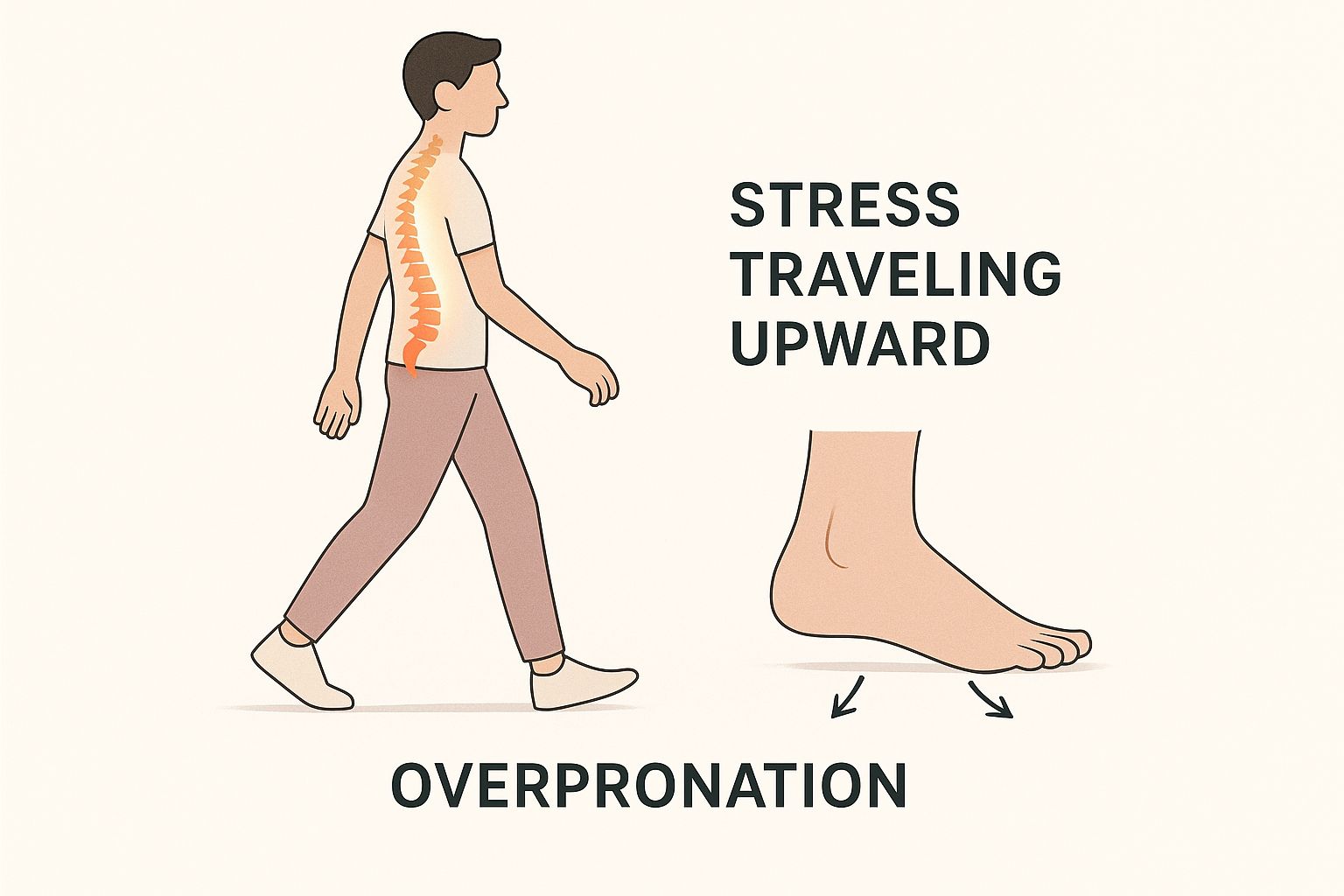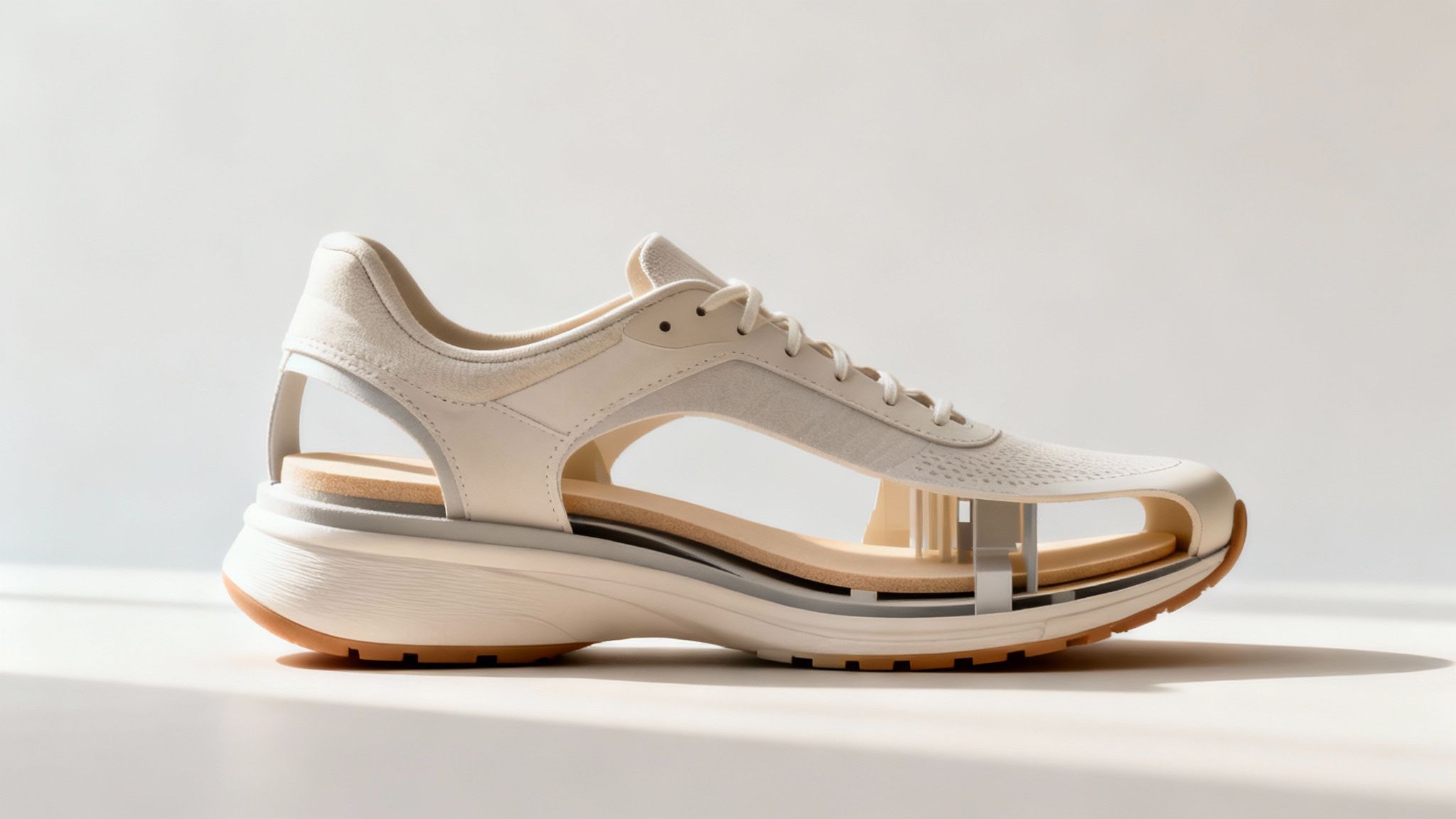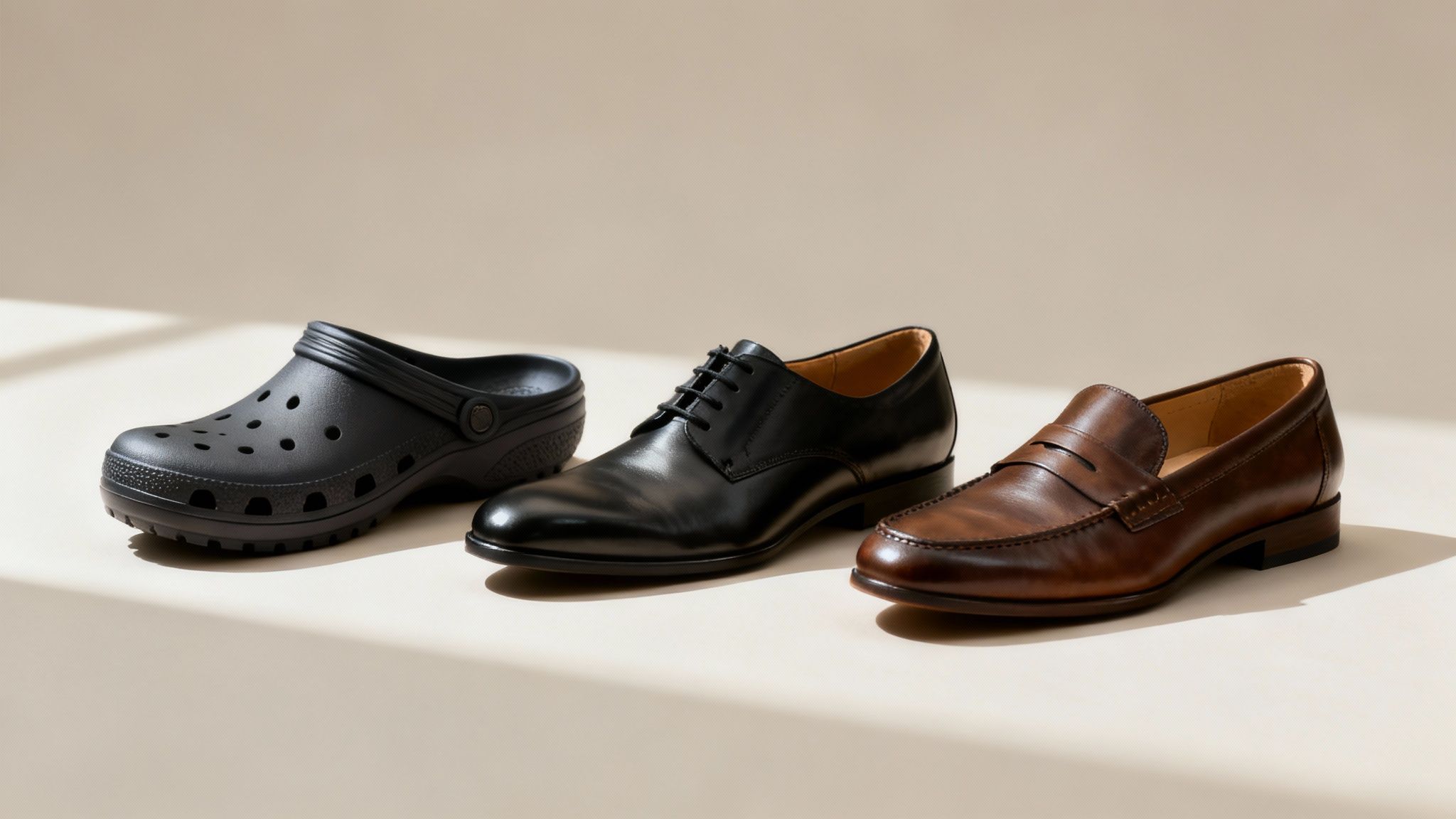Finding the Best Shoes for Lower Back Pain
- Flourish Everyday Health And Fitness

- Oct 19
- 10 min read
Updated: Oct 23
If you've ever felt that nagging ache in your lower back, you've probably blamed your mattress or your office chair, but what if the real culprit is your shoes? Picking the right footwear can be a game changer. Pairs with proper cushioning and arch support help improve posture and absorb impact, taking significant strain off your spine. Brands like Hoka, Brooks, and New Balance are often recommended for this reason, providing the stability needed to alleviate back stress.

Table of Contents
The Hidden Connection Between Your Feet and Back Pain
It might sound strange, but finding the best shoes for lower back pain could start with the way you walk. Think of your body as a tower. If the foundation is wobbly, the entire structure struggles to stay balanced. This is what happens when your shoes lack proper support.
This infographic breaks down how poor foot alignment, like overpronation, can send a shockwave of stress up your body and into your lower back.

When a foot isn't properly supported, it can throw your ankle, knee, and hip out of alignment. Your spine is then forced to compensate, absorbing unnatural stress.
How Your Feet Influence Your Spine
Your body is a connected system known as the kinetic chain. A problem in one area can easily cause trouble elsewhere. Your feet are ground zero for absorbing impact, or "ground reaction forces", from every step you take. Without the right shoes, these jarring forces travel up your legs and settle in your lower back. Good footwear acts as a suspension system, absorbing shock before it causes damage.
For instance, conditions like flat feet or high arches can alter your gait. An unsupportive shoe allows your foot to roll too far inward (overpronation) or outward (supination). This imbalance tilts your pelvis, putting uneven pressure on your lumbar spine. Over time, this constant compensation leads to chronic aches. If this sounds familiar, you might find our guide to the best workout shoes for flat feet in 2025 helpful.
"I often say that everything starts with our feet. The impact of walking, running, dancing, really any movement, carries through from the ground up, affecting not only our feet but also our knees, hips, and lower back." - Dr. Brandon Haghverdian, Orthopedic Surgeon
Choosing shoes designed to correct these imbalances is a proactive step toward lasting relief. By giving your foundation stability, you allow your entire body to align properly, taking the burden off your overworked lower back.
Decoding the Features of a Pain Relief Shoe
Choosing shoes for lower back pain can feel complex, with terms like "heel counter" and "toe box." Understanding these key features is the most important step toward finding relief.
This guide will break it down, helping you know exactly what to look for.

A good pain relief shoe is a tool engineered to support your body's foundation. Each part has a job, and when they work together, they create a stable base that takes significant strain off your spine.
The Anatomy of a Supportive Shoe
Here are the nonnegotiable that make a shoe genuinely back friendly. When trying on a new pair, check for these four critical components that protect your posture and absorb daily impact.
Strategic Cushioning: More than just a soft insole, proper cushioning in the midsole acts as a shock absorber. It dampens the jarring forces from each step that would otherwise travel to your lower back.
Structured Arch Support: Your arch is your foot's natural suspension bridge. Good support prevents it from collapsing, which stops your foot from rolling inward (overpronation). This is crucial for keeping your knees, hips, and spine aligned.
A Firm Heel Counter: This rigid, cup-shaped section encircles your heel. A firm heel counter locks your foot in place, preventing wobbling and creating a stable base for a more efficient stride.
A Spacious Toe Box: The front of the shoe must be wide enough for your toes to spread naturally. This improves your balance and helps distribute your body weight evenly, preventing instability that can lead to back strain.
Essential Shoe Features for Back Pain Relief
This table summarizes the most important shoe characteristics and how they help reduce stress on your lower back.
Feature | What It Does | How It Helps Your Back |
|---|---|---|
Strategic Cushioning | Absorbs the impact force every time your foot hits the ground. | Reduces the jarring shock that travels up the kinetic chain to your spine. |
Structured Arch Support | Prevents the arch of the foot from collapsing inward (overpronation). | Maintains proper body alignment from the feet up, preventing strain on the hips and back. |
Firm Heel Counter | Stabilizes the heel and prevents excessive side-to-side foot movement. | Creates a stable foundation for each step, promoting a more balanced and efficient gait. |
Spacious Toe Box | Allows your toes to splay naturally, providing a wider base of support. | Improves overall balance and distributes body weight more evenly, reducing instability. |
Looking at shoes this way helps you focus on function over brand names.
A well constructed shoe provides a stable and supportive base, which is fundamental for proper body alignment. By controlling foot motion and absorbing shock, the right footwear can significantly reduce the mechanical stress placed on the lower back during daily activities.
Why These Features Matter More Than Brand Names
While some brands have a good reputation, the features themselves provide relief. The orthopedic footwear market was valued at over USD 4.37 billion in 2024 and is expected to grow to USD 15.45 billion by 2037, showing a rising awareness of the link between foot health and overall well-being.
Understanding how a shoe supports you is more important than its logo. For a deeper dive, check our guide on how to choose running shoes. Prioritizing cushioning, support, stability, and space will help you find a pair that truly supports your journey to a pain free back.
Top Athletic Shoe Recommendations for Men and Women
When choosing athletic shoes to help with lower back pain, focus on supportive technology. Whether for the gym or daily errands, the right sneaker can reduce spinal strain. Brands like Hoka, Brooks, and New Balance invest in biomechanical research to create features that promote proper alignment.
Neutral vs. Stability Shoes: What’s the Difference?
Understanding the two main types of athletic shoes, neutral and stability, is crucial.
Neutral Shoes: Designed for a "neutral" gait where feet and ankles stay aligned. They focus on cushioning to absorb impact without offering corrective support.
Stability Shoes: Built for overpronators, whose foot arches collapse and roll inward. Stability shoes use features like firmer midsole foam or "guide rails" to limit this motion, keeping the leg and spine better aligned.
Choosing the wrong type can worsen alignment issues. A "wet test" at home or a professional gait analysis can help determine your foot type.
When your feet are properly supported, the positive effects travel up your body. A good shoe helps your gait become more efficient, reducing the twisting forces that affect your knees, hips, and lower back.
Top Picks for Back Pain Relief
Here are standout models known for features that relieve back pressure.
For Maximum Cushioning: Hoka is known for its "maximalist" designs with oversized midsoles offering superior shock absorption.
Top Model: The Hoka Bondi (for men and women) provides a plush feel that minimizes stress on joints and the lower back, ideal for walking or long hours on your feet.
For Guided Stability: Brooks excels at creating smooth, stable shoes. Their Guide Rails technology gently guides feet into proper alignment.
Top Model: The Brooks Adrenaline GTS offers solid support for overpronators, correcting inward foot roll and stabilizing the body from the ground up.
For Versatile Support: New Balance is known for durable, supportive shoes, often available in multiple widths for a customized fit.
Top Model: The New Balance Fresh Foam X 860 is a top-tier stability shoe that balances supportive features with soft cushioning for comfortable, controlled everyday wear.
While specialized shoes like rocker soles are marketed for back pain, it's important to look at the evidence. A clinical study found that patients using conventional sports shoes reported a greater reduction in disability from lower back pain than those using rocker soles. You can read the full research on rocker shoes and back pain to see the data. A well designed, traditional athletic shoe is often the most reliable choice.
Choosing Supportive Shoes for Work and Daily Life
Supportive footwear isn't just for workouts. Long hours standing or walking at work are a major source of lower back pain. It's essential to find shoes that blend all day comfort with a professional look, ensuring your back is supported throughout the day.

The right shoes for lower back pain must have the same core features as a great athletic shoe: a firm heel counter, structured arch support, and ample cushioning. Work-specific shoes might also need features like slip resistant soles for safety, which adds another layer of stability.
Modern orthopedic tech, like memory foam and shock absorbing soles, is designed to directly reduce stress on the spine. It does this by promoting better posture and cushioning every single step you take.
The global orthopedic shoes market is projected to reach USD 10.7 billion by 2035, growing at about 9.4% annually. This growth reflects a greater understanding of how proper footwear can prevent chronic pain.
Top Brands for Professional Support
Several brands merge orthopedic benefits with workplace style.
Dansko: A favorite among healthcare professionals, their clogs offer excellent arch support and a rocker bottom sole that promotes a natural walking motion, reducing fatigue and back strain.
Vionic: Known for podiatrist-designed orthotics built into their shoes. Vionic offers a wide range of styles, all engineered to support natural alignment.
Clarks: This brand combines comfort technology with classic design. Many of their office ready shoes feature cushioned insoles and supportive construction, making them a reliable choice for all day wear.
Choosing a work shoe from a brand that prioritizes biomechanics is an investment in your spinal health. These shoes absorb impact and maintain alignment, addressing the root cause of work related back pain.
Know When to Replace Your Shoes
Even the best shoes wear out. The supportive midsole foam compresses over time, losing its ability to absorb impact. Wearing worn out shoes removes the protective features that help your back.
Watch for these signs of wear:
Mileage: Replace athletic shoes every 300-500 miles.
Visible Wear: Look for uneven tread wear or deep creases in the midsole foam.
How They Feel: If the cushioning feels flat or old aches return, it’s time for a new pair.
Supportive footwear is a tool. Like any tool, it must be maintained and replaced to function correctly. Ignoring wear and tear can undo their benefits, allowing harmful impact forces to travel back up to your spine.
Complementary Habits for Lasting Relief
Supportive shoes work best with other healthy practices. Simple lifestyle changes can dramatically improve your back health.
Focus on flexibility and strength. Daily stretches, like hamstring stretches or cat-cow poses, release tension in the muscles supporting your spine. A strong core acts as a natural corset for your lower back. For guidance, see our article on the best core workouts for a stronger midsection.
Be mindful of your posture. When sitting, keep your feet flat and your back straight. When standing, distribute your weight evenly. These small adjustments prevent chronic strain. Finally, maintaining a healthy weight reduces the load on your spine, which can make a significant difference in your comfort.
Your Top Questions About Shoes and Back Pain, Answered
Finding the right shoe can be confusing. Here are answers to some of the most common questions about the link between footwear and lower back pain.
Can Totally Flat Shoes Like Flip-Flops Really Cause Back Pain?
Yes, they are a common culprit. Most flip-flops and other flat shoes offer zero arch support and minimal cushioning. This forces the muscles in your feet to work overtime to maintain stability. This lack of support can lead to overpronation, where your foot's arch collapses inward. This creates a chain reaction up your legs, potentially tilting your pelvis and putting uneven strain on your lower back.
How Do I Know If I Need a Neutral or a Stability Shoe?
A professional gait analysis is the best way, but the "wet test" at home can give you a good idea of your arch type.
Wet the bottom of your foot.
Step firmly onto a piece of cardboard or a dark towel.
Examine the footprint.
If you see most of your footprint, you likely have flat feet and could benefit from a stability shoe. If you see very little of the middle of your foot, you have high arches, and a cushioned neutral shoe is probably best. A print somewhere in between suggests a neutral shoe is a good starting point.
The goal is to find a shoe that works with your foot's natural mechanics. A stability shoe corrects an unstable foot, while a neutral shoe cushions a foot that is already functioning correctly.
Are Super Expensive Orthopedic Shoes Always the Best Choice?
No. The "best" shoe is one that fits your foot and provides the necessary cushioning, arch support, and stability. A well designed athletic shoe that meets these criteria can be just as effective as a pricey "orthopedic" shoe. Focus on the core features we’ve discussed rather than the price tag. A well-made shoe from a trusted brand like Hoka, Brooks, or New Balance that matches your gait is a smart investment in your back health.
How Often Should I Replace My Shoes to Keep My Back Happy?
The cushioning and support materials break down with use, often before the shoe looks worn out. For running or walking shoes, a good rule is to replace them every 300-500 miles. For everyday work shoes, plan on replacing them every 8 to 12 months, especially if you are on your feet a lot. If the cushioning feels dead, the treads are worn, or old aches return, it’s time for a new pair.
At Flourish-Everyday, our goal is to help you find the perfect gear to support your active, healthy lifestyle. Check out our in-depth reviews and recommendations to take the next step on your wellness journey.
References
Future Market Insights. (2024). Orthopedic Shoes Market Outlook (2024 to 2034). Retrieved from https://www.futuremarketinsights.com/reports/orthopedic-shoes-market
Research Nester. (2024). Orthopedic Footwear Market: Global & Regional Industry Outlook (2024-2037). Retrieved from https://www.researchnester.com/reports/orthopedic-footwear-market/2508
Shakoor, N. (2022, November 28). Rocker Shoes and Back Pain. IASP Relief News. Retrieved from https://www.iasp-pain.org/publications/relief-news/article/rocker-shoes-and-back-pain/

Comments